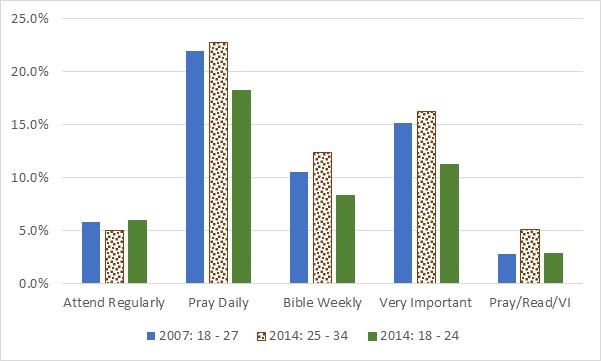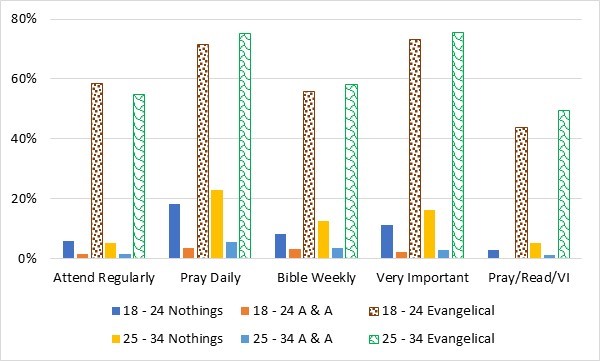As we have seen in previous blogs, the percentage of young adults who identify as Nones has been increasing rapidly over the last two decades. During the same time, Christian groups have seen a decline in the percentage of young adults who identify with them. But looking back at their childhood affiliations, we want to know 1) Where did these Nones come from and 2) Did any who grew up in a None household become Christians.
Looking at the Pew Research, U.S. Religious Landscape Survey 2014{1}, we can answer these questions and others about the transition from childhood faith to adult faith.
In the first part of this post, we will consider Americans who were 25 to 34 years old in 2014. This age group is of interest because they represent those from post-college through the beginning of child rearing and because we can compare them with 18 to 24-year-olds from the 2007 Pew Research survey.
The two tables below look at the change from two different perspectives. The first looks at where young adults with a particular religious affiliation came from as children. The second looks at where children of a particular religious affiliation ended up as young adults.
Let’s consider a simple example to understand the difference between these two tables. Assume that there were 200 Evangelicals and 200 Nones in 2014 and there were 100 Evangelicals and 300 Nones among the same group as children. Finally, assume that there were 25 people who were Nones as children who became Evangelical as an adult. That tells us that 125 Evangelical children became Nones as an adult.
Given this data, the first table would be:
| Evangelical Adult | None Adult | |
| Evangelical as Children | 75%(75/100) | 41.7% (125/300) |
| None as Children | 25% (25/100) | 58.3% (175/300) |
| Total | 100% | 100% |
And the second table would be:
Example 2: Religion Children Became as Adults
| Evangelical Adult | None Adult | Total | |
| Evangelical as Children | 37.5% (75/200) | 62.5% (125/200) | 100% |
| None as Children | 12.5% (25/200) | 87.5% (175/200) | 100% |
With that as background, let’s look at our two tables.
Table 1: Religion 25 to 34-year-old Adults Came From as Children
| Religion as a Child | Evangelical | Mainline | Black | Catholic | Other | None | Change | % Leaving |
| Evangelical-C | 62.7% | 19.2% | 6.2% | 1.5% | 5.4% | 16.0% | 98.1% | 38.4% |
| Mainline-C | 10.5% | 53.0% | 2.4% | 1.9% | 8.2% | 17.7% | 69.1% | 63.4% |
| Black-C | 3.8% | 2.1% | 73.5% | 1.0% | 3.4% | 5.4% | 77.3% | 43.2% |
| Catholic-C | 13.5% | 13.7% | 6.5% | 92.6% | 10.3% | 27.1% | 54.6% | 49.4% |
| Other-C | 1.7% | 2.9% | 3.1% | 0.5% | 65.4% | 11.1% | 91.3% | 40.3% |
| None-C | 7.7% | 9.1% | 8.4% | 2.5% | 7.4% | 22.7% | 280.8% | 36.3% |
| Total | 100% | 100% | 100% | 100% | 100% | 100% | ||
| Evangelical-C stands for “Evangelical as a child” and so on | ||||||||
Table 2: Religion Children Ended Up Affiliating with as 25 to 34-year-old Adults
| Religion as a child | Evangelical | Mainline | Black | Catholic | Other | None | Total |
| Evangelical-C | 61.6% | 9.0% | 1.7% | 1.1% | 2.6% | 24.1% | 100% |
| Mainline-C | 15.2% | 36.6% | 0.9% | 2.2% | 5.7% | 39.4% | 100% |
| Black-C | 10.6% | 2.8% | 56.8% | 2.1% | 4.5% | 23.2% | 100% |
| Catholic-C | 9.8% | 4.7% | 1.3% | 50.6% | 3.6% | 30.1% | 100% |
| Other-C | 3.2% | 2.6% | 1.6% | 0.7% | 59.7% | 32.3% | 100% |
| None-C | 14.2% | 8.0% | 4.2% | 3.5% | 6.5% | 63.7% | 100% |
| Evangelical-C stands for “Evangelical as a child” and so on | |||||||
First, let’s consider the Nones.
Looking at Table 1, we see that the greatest percentage of Nones were affiliated with the Catholic church as children (27.1%) while a smaller percentage were actually Nones as children (22.7%). But lest we think this is only a Catholic issue, we find almost 34% (16.0% + 17.7%) of them were affiliated with a Protestant church as children.
From Table 2, we see that almost 40% of Mainline Protestant children became Nones by the time they were 25 to 34-year-olds. Shockingly, more Mainline Protestant children became Nones than stayed affiliated with a Mainline denomination (39.4% to 36.6%). Strikingly, every other religious grouping lost at least one in four of their childhood affiliates to the Nones; with Catholics and Other Religions losing about one out of three. It is important to highlight that one out of four children raised as Evangelicals chose to be characterized as a None as young adults. Even though that percentage is smaller than other religious groups, one of four is still a significant percentage.
Now let’s look at the columns in Table 1 labeled Change and % Leaving. For this age group, there are almost three times as many Nones as adults as there were as children (i.e. 280.8%). Comparing it with other religious groups, we see that all other groups fell in size. Interestingly, over one third of those who were Nones as children are now affiliated with another religious group. But that group is overwhelmed by the number becoming Nones from other groups.
What about Evangelicals, Mainlines and Catholics?
From Table 1, we see that two-thirds of adult evangelicals age 25 to 34 were evangelical as children. Most of the remaining one third came from either Catholic (13.5%) or Mainline (10.5%) backgrounds. However, looking at Table 2, we note that 14% of those who selected None as children were affiliated with an Evangelical church as young adults. This group makes up only 8% of the Evangelical young adults because the Evangelicals are a larger group than the Nones were as children.
The group that lost almost two-thirds of childhood affiliates is Mainline Christian churches. From Table 2, we see that almost 40% of them became Nones and another 15% became Evangelical. Looking at the Change column for Table 1, we note that the number of Mainlines is down to less than two-thirds of the number who affiliated with Mainline churches as children.
However, the Catholics do even worse. The Change column shows that the number of young adult Catholics is barely one half of the number who said they were affiliated with a Catholic church as children. The Mainlines do a little better because they picked up a significant number of Evangelical and Catholic children while the Catholic faith picks up very few from any other religion (compare Table 1 the column labeled Mainline with the column labeled Catholic to see this difference).
Conclusion
The vast majority of young adult Nones are not raised in households directly promoting that viewpoint. In fact, only 23% of young adult Nones said they were Nones as children. Clearly, the teaching of the culture at large and the lack of a compelling argument from their families is causing the other 77% of young adult Nones to leave their childhood faith to embrace nothing at all.
Relative to their childhood affiliation, the number of Nones is exploding among American young adults. If we, as Evangelicals in America, want to change this trend we need to be equipping our teenagers and emerging adults with a deep understanding of why we know the gospel of Jesus Christ is true and worth giving your life in service to. I encourage you to check out Probe’s Periscope material at upPeriscope.com as a good place to start the process
.
Note
1. The U.S. Religious Landscape Survey 2014, Pew Forum on Religion & Public Life (a project of The Pew Research Center). The Pew Research Center bears no responsibility for the analyses or interpretations of the data presented here. The data were downloaded from the Association of Religion Data Archives, www.TheARDA.com, and were collected by the Pew Research Center.
 First, let’s consider the religious practices of the Nothing in Particulars. In Figure 1, we see their commitment to some common behaviors of nominal and committed Christians. The actual questions are:
First, let’s consider the religious practices of the Nothing in Particulars. In Figure 1, we see their commitment to some common behaviors of nominal and committed Christians. The actual questions are: How do these levels relate to the responses from Evangelicals on the one hand and from Atheists and Agnostics on the other hand? Figure 2 gives us the answer to this question.
How do these levels relate to the responses from Evangelicals on the one hand and from Atheists and Agnostics on the other hand? Figure 2 gives us the answer to this question.